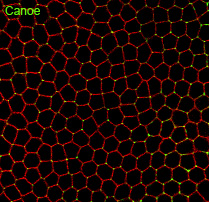Kia Perez-Vale
Background & Contact Information
Position Graduate Student (2016-Present)
Education: BS, University of Puerto Rico-Arecibo 2014; UNC PREP 2014-2015
Fellowships & Awards: NIH F31 Graduate Fellowship; NIH T32 Training Program in Genetics and Molecular Biology
Email: kiaperez@unc.edu
 Research Information
Research Information
During embryonic development, cells need to multiply, differentiate, change shape, and move to ultimately create our body architecture. A key question that drives my dissertation work is: how can epithelial cells change shape and move while maintaining their organization and integrity? Proper tissue organization requires the cell-cell adherens junctions (AJ) to be connected to the actomyosin cytoskeleton, as well as cell polarity establishment and maintenance. I investigated the role and mechanism of action of Canoe, a multidomain protein that acts as an AJ-cytoskeletal linker, during Drosophila development. The overarching theme emerging from my work is that the machinery mediating AJ-cytoskeleton linkage and apical-basal polarity establishment does not form a simple linear pathway. Instead, a complex multivalent network of protein, in which each interaction has different degrees of importance, with some essential while other dispensable, is involved.
First, I investigated how the small GTPase Rap1 regulates Canoe during apical-basal polarity establishment. I found that Canoe’s cortical localization during polarity establishment is regulated by active Rap1, which binds Canoe’s RA domains. Strikingly, Canoe’s RA domains are dispensable for membrane localization, but critical for apical restriction and tricellular junction (TCJ) enrichment. Dizzy, a Rap1 activator, is essential for Canoe’s TCJ enrichment. Second, I investigated how Canoe works as an AJ-cytoskeletal linker ensuring tissue robustness under mechanical tension. Our data revealed that during germband elongation and dorsal closure Canoe reinforces junctions under tension and in its absence Polychaetoid plays a parallel role. Embryos lacking both Canoe and Polychaetoid have early junctional failure leads to loss of tissue integrity. Third, I began to define how Canoe works as a machine, beginning in a situation where the functions of Canoe’s multiple domains were largely unexplored in vivo. I discovered that Canoe’s PDZ and F-actin binding domains are dispensable for viability, and for Canoe AJ localization and TCJ enrichment. The F-actin binding domain reinforces junction under mechanical tension. However, Canoe’s RA domains are important for its TCJ and vertical border enrichment during planar polarity, which are areas of high tension. My work reinforces the idea that multiple inputs ensure tissue integrity during development. Finally, I worked with Kristi Yow to explore how Canoe’s upstream activator, the small GTPas Rap1, functions during embryonic morphogenesis. Rap1 uses Canoe as one effector, regulating junctional planar polarity. However, Rap1 has additional roles in junctional protein localization and balanced apical constriction-in its absence, Bazooka/Par3 localization is fragmented, and cells next to mitotic cells apically constrict and invaginate, disrupting epidermal integrity. In contrast, the GEF Dizzy has phenotypes similar to but slightly less severe than Canoe loss, suggesting that this GEF regulates Rap1 action via Canoe. Taken together, these data reveal that Rap1 is a crucial regulator of morphogenesis, likely acting in parallel via Canoe and other effectors, and that different Rap1 GEFs regulate distinct functions of Rap1.
Publications
Perez-Vale, KZ., Yow, K,D., Johnson, R, I,. Byrnes, A.E., Finegan, T.M., Slep, K.C., and Peifer, M. (2021) Multivalent interactions make adherens junction-cytoskeletal linkage robust during morphogenesis. Journal of Cell Biology 220:e202104087..
Perez-Vale, K.Z, and Peifer, M. (2020). Orchestrating morphogenesis: building the body plan by cell shape changes and movements. Development 147, dev191049.
Manning, L.A., Perez-Vale, K.Z., Schaefer, K.N., Sewell, M.T., Peifer, M. (2019). The Drosophila Afadin and ZO-1 homologs Canoe and Polychaetoid act in parallel to maintain epithelial integrity when challenged by adherens junction remodeling. Molecular Biology of the Cell 30,1938-1960.
Perez-Vale, K.Z., and Peifer, M. (2018). Modulating Apical-Basal Polarity by Building and Deconstructing a Yurt. Journal of Cell Biology 217,3772-3773.
Bonello, T.T., Perez-Vale, K.Z., Sumigray, K.D., and Peifer, M. (2018) Rap1 acts via multiple mechanisms to position Canoe/Afadin and adherens junctions and mediate apical-basal polarity establishment. .



